

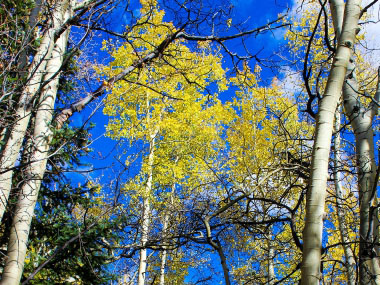
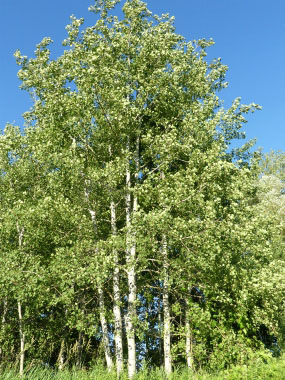
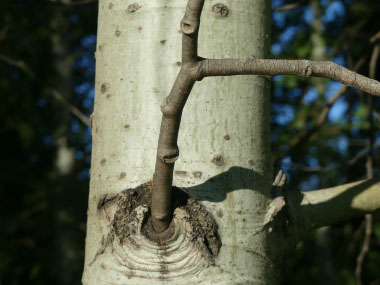

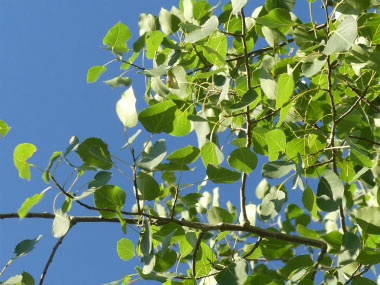
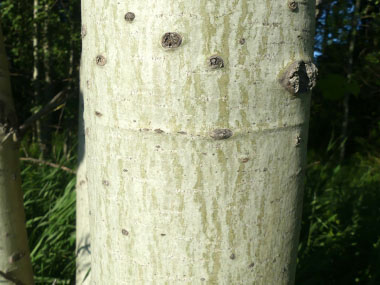

To support our efforts please browse our store (books with medicinal info, etc.).
Populus tremuloides, commonly called quaking aspen, is perhaps most noted for its beautiful white powdery bark, its deep green foliage that quakes in the slightest breeze and its golden yellow fall foliage colour. Interestingly, the leaves have a flat petiole which is stronger in one direction than the other which allows the leaves to flutter in the slightest breeze. It is this fluttering that gives this tree its common name quaking or trembling Aspen. Quaking aspen wood has a multitude of uses from canoe paddles to helping with health issues. This tree hybridizes naturally with big tooth aspen and white poplar. Other names this is known by include golden aspen, mountain aspen, poplar and trembling poplar. Quaking aspen is in the willow (Salicaceae) family.
Trunk/Bark
Trunk bark is variable, depending on the age of a tree. On a mature tree, the bark at the base of the trunk is coarse, gray, and furrowed, becoming more smooth and light-coloured above. On immature trees, the trunk bark is white to light yellowish gray and relatively smooth; there are usually black horizontal rings and scattered black knots along the trunk.
Branches/Twigs
The bark of larger branches is similar in appearance to the trunk bark of immature trees. Small branches are light brown and warty from abundant lenticels, while twigs are light to dark brown and glabrous. Young shoots are light green or yellowish green and glabrous.
Height
It can be as tall as 40 metres (120') with a trunk diameter of 60cm (23”).
Leaves/Needles
Leaves grow alternate, simple, 2.5 to 7.5 cm (1 - 3") long, green above and lighter below, heart-shaped to nearly round with a fine-toothed margin and a pointed tip. The petiole is flattened.
Flowers
Flowers appear before the leaves in the spring as catkins with male and female flowers on separate trees (clones). Seed pods mature along the central stem of the hanging female catkin.
Fruit
Catkins are 5 to 10 cm (2 to 4") long, with attached light green capsules which contain many small hairy seeds.
Habitat
Quaking aspen is generally found in well drained fertile soils yet it can grow in areas with heavy clay soils (but the trees are much smaller). This tree is one of the most wildly distributed trees throughout North America. Quaking aspen also tends to be a disturbed habitat species, meaning it often lives where avalanches, mudslides and fires occur frequently. Quaking aspen spans an elevational range from sea level on both coasts to 3,505 metres ( 11,500') in northern Colorado. Trembling aspen can form expansive colonies by sending up new trunks as an old trunk dies. One colony in Utah is estimated to be over 80,000 years old.
Edible Parts
Much of the tree is edible. You can eat the inner bark and cambium but it is best in the spring. It can be dried, ground into a powder and used as a flour. For those who have used it, they say that this flour is normally mixed with other flours for making bread. It also can be used as a thickener for soups. This tree can be tapped for the sap and it can be made into syrup. Catkins can be consumed raw or cooked. At on time the ashes were used as a source of salt. The white powder on the bark has reportedly been used as yeast. Although useful, this is a tree that is conside red as famine food. The buds are a good source of calcium, fibre and vitamin A.
Other Name
Trembling Aspen.
Recipes
Winter Survival Food Handbook

PDF Plant Magazines
Types of Wild Food
Geographic Zones Seasons
Disclaimer
EdibleWildFood.com is informational in nature. While we strive to be 100% accurate, it is solely up to the reader to ensure proper plant identification. Some wild plants are poisonous or can have serious adverse health effects.
We are not health professionals, medical doctors, nor are we nutritionists. It is up to the reader to verify nutritional information and health benefits with qualified professionals for all edible plants listed in this web site. Please click here for more information.
Why Edible Wild Food?
- Food costs are rising
- Free, wild food is readily abundant
- Wild food adds nutrition to your diet
- Wild food can help treat various medical conditions





